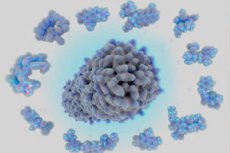New publications
Can the 'quality' of β cells determine whether you develop diabetes?
Last reviewed: 03.08.2025

All iLive content is medically reviewed or fact checked to ensure as much factual accuracy as possible.
We have strict sourcing guidelines and only link to reputable media sites, academic research institutions and, whenever possible, medically peer reviewed studies. Note that the numbers in parentheses ([1], [2], etc.) are clickable links to these studies.
If you feel that any of our content is inaccurate, out-of-date, or otherwise questionable, please select it and press Ctrl + Enter.

If it seems like more and more people you know are dealing with diabetes, you're right. The diabetes epidemic isn't called an epidemic for nothing: According to the American Diabetes Association, more than 10% of the U.S. population — about 38.4 million people — had diabetes in 2021, with another 1.2 million people being diagnosed each year.
Type 2 diabetes develops when the body becomes resistant to insulin, a hormone that helps regulate blood glucose levels. Insulin is produced by the pancreatic β-cells, and in type 2 diabetes, they increase insulin production in an attempt to normalize sugar levels, but even this is not enough, and the β-cells eventually become exhausted. Because of their key role, the functional mass of β-cells—that is, their total number and ability to function—determines the risk of developing diabetes.
However, β-cells are not uniform even in the same person – they are divided into subtypes, each of which differs in secretory activity, survival, and ability to divide. In other words, each β-cell subtype has a different “fitness level” – and the higher it is, the better. As diabetes develops, the proportions of some β-cell subtypes change. But the key question remains: does diabetes change the composition and condition of β-cells, or is it these changes that lead to the disease?
That’s where scientists Guoqiang Gu, Emily Hodges, and Ken Lau of Vanderbilt University come in. Their recent work, published in the journal Nature Communications, is a step toward understanding whether the functional mass of β cells can be increased to reduce the risk of type 2 diabetes. Gu and Lau are professors of cell and developmental biology, and Hodges is an assistant professor of biochemistry.
Studying β-cell subtypes is not an easy task. The most common method used is “terminal analysis of samples at the single-cell level,” meaning that scientists can study specific β-cells only once — and only when they are fully developed. This does not allow us to track the development of the same cell subtype at different stages: differentiation, maturation, division, aging, death, etc. The ability to observe them at all stages would provide a better understanding of how the state of the cells changes over time or under different physiological conditions.
To overcome this limitation, Gu, Hodges, and Lau developed a method to permanently tag the progenitor cells that give rise to β cells with different combinations of gene expression. These tags allowed the researchers to track the same β cell subtypes at different stages of development, and answer fundamental questions with greater confidence.
Their research yielded three main findings:
- Progenitor cells that form β cells with different genetic markers in mouse embryos give rise to β cell subtypes with different degrees of “fitness” in adult mice. This helps to understand how the subtypes are formed and how this process can be manipulated in the future to increase the proportion of “healthy” β cells and reduce the risk of diabetes.
- The diet of female mice during pregnancy directly affects the ratio of high-functioning to low-functioning β-cells in the offspring. For example, if the mother is fed a high-fat diet and is obese, her offspring have fewer glucose-sensing β-cells. This model confirms that maternal obesity increases the risk of diabetes in the offspring. This gives doctors and researchers a better understanding of the role of heredity and maternal health.
- The β-cell subtypes identified in mice have analogs in the human pancreas. Moreover, the subtype that has the greatest fitness in humans is reduced in patients with type 2 diabetes. While not all animal findings are directly applicable to humans, the results suggest that mouse models may be useful for understanding human biology and diabetes.
The researchers now plan to study how exactly epigenetic patterns (the aforementioned gene expression markers) are formed and maintained in different β-cell subtypes and how their disruption affects cellular function.
"With this and other research, it may be possible in the future to develop a dietary supplement for pregnant women that reduces the risk of diabetes in the child," Gu says.
Other important questions remain: is it possible, for example, to improve the functional quality of β-like cells derived from human embryonic stem cells by modulating DNA methylation (one of the epigenetic markers)? If so, could such β-cells be used in transplant therapy, in which patients with type 2 diabetes are transplanted with β-cells with a high level of fitness?
The answers to these questions remain to be found.
